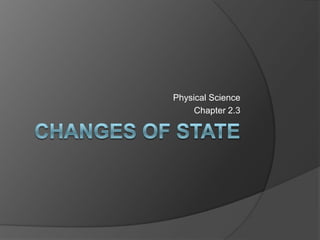Physical Science 2.3 : Changes of State
•Télécharger en tant que PPTX, PDF•
1 j'aime•2,886 vues
Signaler
Partager
Signaler
Partager

Contenu connexe
Tendances
Tendances (20)
what is saturated,unsaturated and supersaturated solution

what is saturated,unsaturated and supersaturated solution
En vedette
En vedette (20)
Similaire à Physical Science 2.3 : Changes of State
Similaire à Physical Science 2.3 : Changes of State (20)
Unit c heat & temperature notes(changes between states)

Unit c heat & temperature notes(changes between states)
Plus de Chris Foltz
Plus de Chris Foltz (20)
Dernier
Mattingly "AI & Prompt Design: The Basics of Prompt Design"

Mattingly "AI & Prompt Design: The Basics of Prompt Design"National Information Standards Organization (NISO)
Organic Name Reactions for the students and aspirants of Chemistry12th.pptx

Organic Name Reactions for the students and aspirants of Chemistry12th.pptxVS Mahajan Coaching Centre
“Oh GOSH! Reflecting on Hackteria's Collaborative Practices in a Global Do-It...

“Oh GOSH! Reflecting on Hackteria's Collaborative Practices in a Global Do-It...Marc Dusseiller Dusjagr
Dernier (20)
18-04-UA_REPORT_MEDIALITERAСY_INDEX-DM_23-1-final-eng.pdf

18-04-UA_REPORT_MEDIALITERAСY_INDEX-DM_23-1-final-eng.pdf
Mattingly "AI & Prompt Design: The Basics of Prompt Design"

Mattingly "AI & Prompt Design: The Basics of Prompt Design"
Presentation by Andreas Schleicher Tackling the School Absenteeism Crisis 30 ...

Presentation by Andreas Schleicher Tackling the School Absenteeism Crisis 30 ...
Z Score,T Score, Percential Rank and Box Plot Graph

Z Score,T Score, Percential Rank and Box Plot Graph
Organic Name Reactions for the students and aspirants of Chemistry12th.pptx

Organic Name Reactions for the students and aspirants of Chemistry12th.pptx
Contemporary philippine arts from the regions_PPT_Module_12 [Autosaved] (1).pptx![Contemporary philippine arts from the regions_PPT_Module_12 [Autosaved] (1).pptx](data:image/gif;base64,R0lGODlhAQABAIAAAAAAAP///yH5BAEAAAAALAAAAAABAAEAAAIBRAA7)
![Contemporary philippine arts from the regions_PPT_Module_12 [Autosaved] (1).pptx](data:image/gif;base64,R0lGODlhAQABAIAAAAAAAP///yH5BAEAAAAALAAAAAABAAEAAAIBRAA7)
Contemporary philippine arts from the regions_PPT_Module_12 [Autosaved] (1).pptx
Measures of Central Tendency: Mean, Median and Mode

Measures of Central Tendency: Mean, Median and Mode
“Oh GOSH! Reflecting on Hackteria's Collaborative Practices in a Global Do-It...

“Oh GOSH! Reflecting on Hackteria's Collaborative Practices in a Global Do-It...
Web & Social Media Analytics Previous Year Question Paper.pdf

Web & Social Media Analytics Previous Year Question Paper.pdf
Physical Science 2.3 : Changes of State
- 1. Changes of state Physical Science Chapter 2.3
- 2. Objectives Describehow energy is involved in changes of state. Describewhat happens during melting and freezing. Compareevaporation and condensation. Explainwhat happens during sublimation. Identifythe two changes that can happen when a substance loses or gains energy. Bellringer Write a description of what must be done to liquid water to change it to ice or to change it to steam. Based on your explanation, predict what must happen to cause matter to change state.
- 3. Energy and changes of state Change of state change of a substance from one physical form to another. Particles move differently depending on the state of the substance. Particles also have different amounts of energy when the substance is in different states.
- 5. Melting: Solid to Liquid Melting change of state from a solid to a liquid. Melting point The temperature at which a solid changes to a liquid Adding Energy For a solid to melt, particles must overcome their attractions to each other. At the melting point, any energy added is used to overcome attractions between particles.
- 6. Freezing: Liquid to Solid Freezing Change of state from a liquid to a solid. Freezing point Temperature at which a liquid changes to a solid. Removing Energy When a liquid is at its freezing point, removing energy will cause the particles to begin locking into place.
- 7. Evaporation: Liquid to Gas Evaporation Change of state from a liquid to a gas. Evaporation can occur at the surface of a liquid that is below its boiling point. Boiling Change of a liquid to a gas throughout the liquid. boiling point Temperature at which a liquid boils.
- 9. Effects of Pressure on Boiling Point The boiling point of a liquid decreases as atmospheric pressure decreases. Atmospheric pressure is caused by the weight of the gases in the atmosphere. Atmospheric pressure is lower at higher elevations. So, the boiling point is lower on top of mountains than it is at sea level.
- 10. Condensation: Gas to Liquid Condensation change of state from a gas to a liquid. Condensation point the temperature at which the gas becomes a liquid. Removing Energy slows the movement of gas particles which allows them to clump together.
- 11. Sublimation: Solid to Gas Sublimation Change of state in which a solid changes directly into a gas. Must Gain Energy For sublimation to occur, the attractions between the particles must be completely overcome.
- 12. Change of Temperature vs. Change of State When most substances lose or gain energy 2 Possibilities: temperature change state change Temperature of a substance does not change until a change of state is complete.